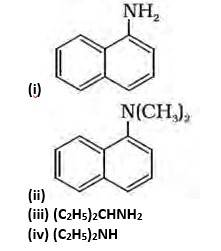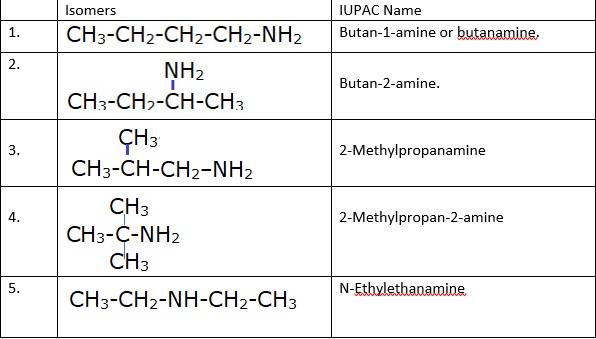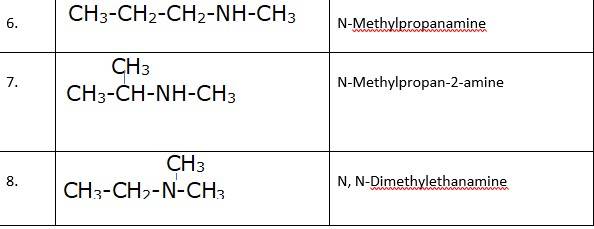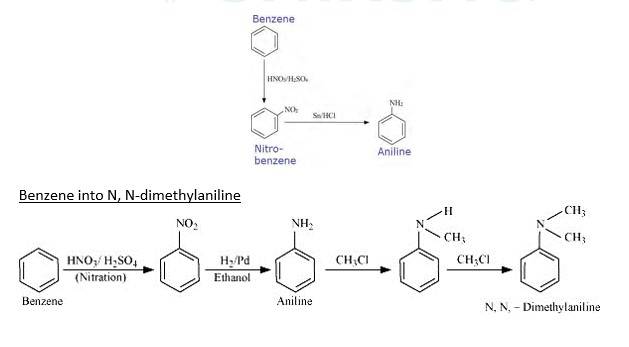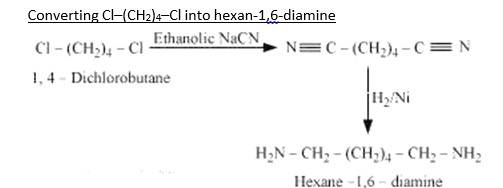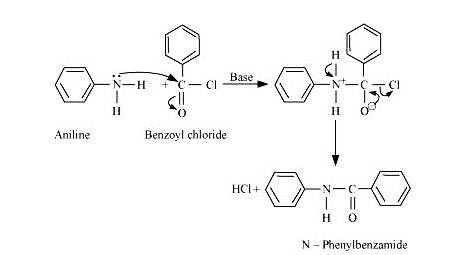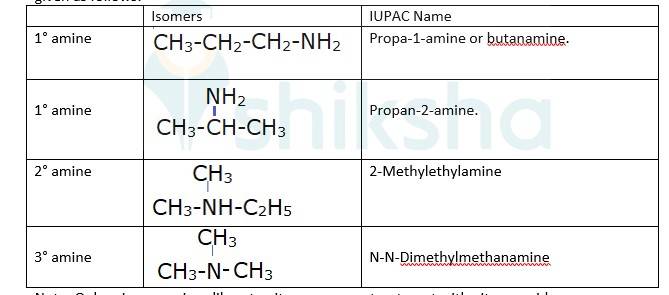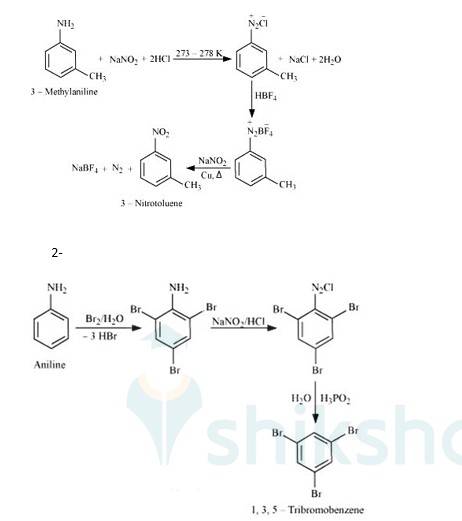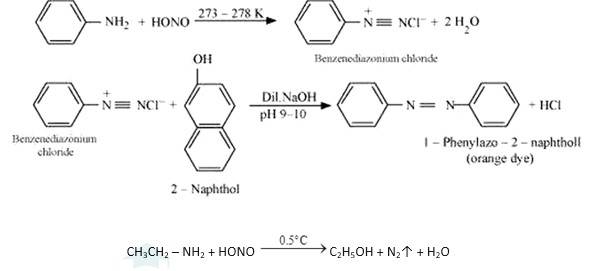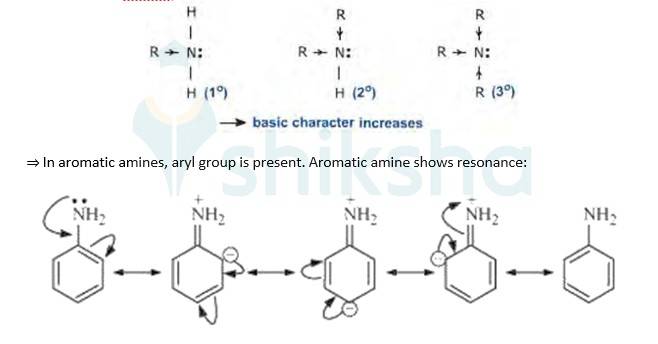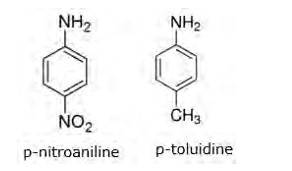NCERT Chemistry Class 12 Solutions Amines: Amines can be considered as derivatives of ammonia, obtained by replacement of one, two or all the three hydrogen atoms by alkyl and/or aryl groups. In nature, amines occur among proteins, vitamins, alkaloids and hormones. Synthetic examples of amines include polymers, dyestuffs and drugs. Two biologically active compounds, namely adrenaline and ephedrine, both containing secondary amino group, are used to increase blood pressure.
Candidates can check here NCERT Class 12 Chemistry Solutions for Amines. The solutions provided here are formulated by subject experts and are written in easy to understand language.
Topics Covered in NCERT Class 12 Chemistry Amines
Candidates can check here the list of all topics covered in NCERT Chemistry Class 12 Amines chapter
- Structure of Amines
- Classification
- Nomenclature
- Preparation of Amines
- Physical Properties
- Chemical Reactions
- Methods of preparation of Diazonium Salts
- Physical Properties
- Chemical reactions
- Importance of Diazonium salts in Synthesis of aromatic Compounds
NCERT Chemistry Class 12th Solution PDF - Amines Chapter Download
Amines is an important chapter and a variety of questions are asked in class 12 and competitive exams from this chapter. NCERT class 12 Amines solutions provided here would be very helpful in understanding the various concepts of this chapter and scoring good marks.The students can download here the Chemistry NCERT Class 12 PDF with solutions for free.
Download Here: NCERT Solution for Class XII Chemistry Amines PDF
Amines Solutions and FAQs
Get here all the questions of NCERT Class 12th Amines Chapter.
Q 13.1 Classify the following amines as primary, secondary or tertiary.
A 13.1 (i) Primary, because the nitrogen atom is attached to the only 1 carbon atom.
(ii) Tertiary, because the Nitrogen atom is attached to the 3 carbon atoms.
(iii) Primary, because the nitrogen atom is attached to the only 1 carbon atom.
(iv) Secondary, because the nitrogen atom is attached to the only 1 carbon.
Q 13.2 (i) Write structures of different isomeric amines corresponding to the molecular formula, C4H11N. (ii) Write IUPAC names of all the isomers. (iii) What type of isomerism is exhibited by different pairs of amines?
A 13.2 (i) & (ii) There are total 8 geometrical isomers of the given compound.
(iii) a) Pairs 1,2,6,7 Exhibit Position isomerism; means the change in position of the substituent.
- Pairs 1,3 and 1,4 and 2,3 and 2,4 exhibit chain isomerism i.e. in this type of isomerism the different structures can be produced by changing the chain of the
- Pairs 5,6 and 5,7 exhibit metamerism; e. different group on either side of the central atom.
- All Primary amines exhibit functional isomers. All secondary amines share functional isomerism and same for The functional isomerism means same functional group.
Q 13.3 How will you convert (i) Benzene into aniline (ii) Benzene into N, N-dimethylaniline (iii) Cl–(CH2)4–Cl into hexan-1,6-diamine?
A 13.3 Benzene into aniline
When Benzene is treated with HNO3/H2SO4 it forms nitrobenzene. When Nitrobenzene reduced with Sn/HCL it forms Aniline because Sn/HCl is a reducing Mixture.
When Benzene is reacted with nitrating mixture it forms nitrobenzene. When it Reduced H2/Pd in ethanol or Sn/HCl, it forms Aniline. When Aniline reacts 2 times with CH3Cl It forms N, N- dimethylaniline.
When 1,4-dichlorobutane reacts with NaCN it forms Di cyanide compound, After Hydrogenation it forms the Hexane 1,6-Diamine.
Q 13.4 Arrange the following in increasing order of their basic strength:
- (i) C2H5NH2, C6H5NH2, NH3, C6H5CH2NH2 and (C2H5)2NH
- (ii) C2H5NH2, (C2H5 )2NH, (C2H5 )3N, C6H5NH2
- (iii) CH3NH2, (CH3 )2NH, (CH3)3N, C6H5NH2, C6H5CH2 NH2 .
A 13.4 (i) Alkyl group contribute inductive effect which increases the basic strength of
NH3
Then C6H5NH2 is having –I effect that reduces strength. And C6H5CH2NH2 increases the basic strength but not as much as C2H5 group.
Hence final order will be C6H5NH2
- (ii) By taking into consideration –R effect and steric hindrance of groups we can arrange them in the order
C6H5NH2< C2H5NH2<(C2H5)3N<(C2H5)2NH.
Because (C2H5)3N has a lot of steric hindrances that reduces the basic strength.
- (iii) In C6H5NH2 , N is directly attached to the ring that causes delocalization of electrons of the benzene ring. Whereas in case of C6H5CH2NH2 it is not directly connected to benzene ring Hence it has more basic strength.
Due to –I effect of (CH3)3 – a group it has more basic strength than C6H5CH2NH2. Hence final order will be
C6H5NH2< C6H5CH2NH2<(CH3)3N< CH3NH2< (CH3)2NH
Q 13.5 Complete the following acid-base reactions and name the products: (i) CH3CH2CH2NH2 +HCl → (ii) (C2H5 ) 3N + HCl
A 13.5 (i) CH3CH2CH2NH2 + HCl → CH3CH2CH2N+H3Cl-
The final product is (N-propyl ammonium chloride.)
(ii) (C2H5)3N + HCl → (C2H5)3N+HCl-
The final product is (Tri ethyl ammonium chloride)
Q 13.6 Write reactions of the final alkylation product of aniline with excess of methyl iodide in the presence of sodium carbonate solution.
A 13.6

On excessive alkylation with methyl iodide aniline gets converted into N,N,N-Trimethylanilinium iodide. After reacting it with sodium carbonate it get converted into N,N,N-Trimethylanilinium carbonate.
Q 13.7 Write chemical reaction of aniline with benzoyl chloride and write the name of the product obtained.
A 13.7 When aniline is treated with benzoyl chloride in the presence of base it gets converted into N-Phenylbenzamide.
Q 13.8 Write structures of different isomers corresponding to the molecular formula, C3H9 N. Write IUPAC names of the isomers which will liberate nitrogen gas on treatment with nitrous acid.
A 13.8 The different isomers of the molecular formula: C3H9N are given in the table. However only 1° amines will liberate nitrogen gas on the treatment with h=the nitrous acid are given as follows:
Note: Only primary amines liberate nitrogen gas on treatment with nitrous acid.
Q 13.9 Convert (i) 3-Methylaniline into 3-nitrotoluene. (ii) Aniline into 1,3,5 – tribromobenzene
A 13.9 When 3-methylaniline treated with NaNO2 + HCl it gets converted into chlorine complex.
When that complex reacted with HBF4 It gets converted into Barium Fluoride complex. This complex reacts with NaNO2 in presence of copper to give 3-Nitrotoluene.
When aniline reacts with Br2 water it gets converted into 2,4,6 tribromobenzamine. When this further reacted with NaNO2/HCl it forms Chloride complex. This complex forms 1,3,5 tribromobenzene after treating with H3PO2 in presence of water.
Exercise Q 13.1 Write IUPAC names of the following compounds and classify them into primary, secondary and tertiary amines.
(i) (CH3 ) 2CHNH2 (ii) CH3 (CH2 ) 2NH2 (iii) CH3NHCH(CH3 ) 2 (iv) (CH3 ) 3CNH2 (v) C6H5NHCH3 (vi) (CH3CH2 ) 2NCH3 (vii) m–BrC6H4NH2
A 13.1
1 - Methylethanamine
The root name is based on the longest chain with the -NH2 attached. The chain is numbered so as to give the amine unit the lowest possible number. The longest chain is ethane chain which is further suffixed with ‘amine’.
2 - Propan-1-amine
The longest chain here is propane. The naming is such that amine unit should get a lowest possible number. Propane-1-amine can also be written as 1-propylamine.
3 - N−Methyl-2-methylethanamine
The chain is numbered so as to give the amine unit the lowest possible number. The other alkyl group is treated as a substituent, with N as the locant. The N locant is listed before numerical locants. The longest chain is ethane which has a Methyl substituent group.
4 - 2-Methylpropan-2-amine
Propane is the longest chain and is joined to the amine group at the 2nd position. Another substituent methyl group is also at the same position.
5 - N−Methylbenzamine or N-methylaniline
Aniline is considered as the principle group. The other alkyl group is treated as a substituent, with N as the locant.
6 - N-Ethyl-N-methylethanamine
This is a tertiary group of amine. The root name is based on the longest chain with an amine having the lowest possible number. The alkyl groups are treated as substituents with N as the locant.
7 - 3-Bromobenzenamine or 3-bromoaniline
Benzene is considered as the principle group. The substituent is bromine which is numbered 3.
Q 13.2 Give one chemical test to distinguish between the following pairs of compounds. (i) Methylamine and dimethylamine (ii) Secondary and tertiary amines (iii) Ethylamine and aniline (iv) Aniline and benzylamine (v) Aniline and N-methylaniline.
A 13.2 The best test for distinguishing methyl amine and dimethylamine is the Carbylamines test.
Carbylamine Test: Aliphatic and aromatic primary amines on heating with chloroform and ethanolic potassium hydroxide form foul-smelling isocyanides or carbylamines.
In this case, Methylamine (which is an aliphatic primary amine) gives a positive carbylamine test while dimethylamine wont.
Hinsberg’s reagent (benzenesulphonyl chloride, C6H5SO2Cl). can be used to distinguish secondary and tertiary amines.
Hinsberg Test: Secondary amines react with Hinsberg’s reagent to form a product that is insoluble in an alkali. For example, N, N−diethylamine reacts with Hinsberg’s reagent to form N,
N−diethylbenzenesulphonamide, which is insoluble in an alkali. Tertiary amines, however, do not react with Hinsberg’s reagent.
Azo-dye test can be used to distinguish ethylamine and aniline.
Azo-dye test: A dye is obtained when aromatic amines react with HNO2 (NaNO2 + dil.HCl) at 0- 5°C, followed by a reaction with the alkaline solution of 2-naphthol. The dye is usually yellow, red, or orange in colour. Aliphatic amines give a brisk effervescence due to the evolution of N2 gas under similar conditions.
Aniline and benzylamine can be distinguished with the help of nitrous acid.
Nitrous acid test: Benzylamine reacts with nitrous acid to form unstable diazonium salt, which in turn gives alcohol with the evolution of nitrogen gas, while aniline reacts with nitrous acid to form a stable diazonium salt without releasing nitrogen gas.
Carbylamine test can be used to distinguish between Aniline and N-methylaniline.
Carbylamine Test: Primary amines, on heating with chloroform and ethanolic potassium hydroxide, form foul smelling isocyanides or carbylamines. Aniline, being an aromatic primary
amine, gives positive carbylamine test. However, N-methylaniline, being a secondary amine does not.
Q 13.3 Account for the following: (i) pKb of aniline is more than that of methylamine. (ii) Ethylamine is soluble in water whereas aniline is not. (iii) Methylamine in water reacts with ferric chloride to precipitate hydrated ferric oxide. (iv) Although amino group is o– and p– directing in aromatic electrophilic substitution reactions, aniline on nitration gives a substantial amount of m-nitroaniline. (v) Aniline does not undergo Friedel-Crafts reaction. (vi) Diazonium salts of aromatic amines are more stable than those of aliphatic amines. (vii) Gabriel phthalimide synthesis is preferred for synthesising primary amines.
A 13.3 Pkb value is the negative logarithm of the basicity constant (Kb) .i.e., pKb = -logKb
Evidently, smaller the value of pKb , stronger is the base (strong tendency to donate electrons)
⇒ The structure of methyl amine is CH3NH2
⇒ The structure of aniline is:
As a result of resonance, the lone pair of electrons on the nitrogen atom gets delocalized over benzene ring. As a result, electron density on the nitrogen decreases and thus is less easily available to donate electrons making it less basic. In contrast, in methyl amine (CH3NH2), delocalization of the lone pair of electrons on the nitrogen atom by resonance is not possible. Furthermore, CH3 being an electron- releasing group, due to which +I effect of CH3 increases the electron density on the N- atom and thus is more easily available to donate electrons making it more basic.
Therefore, aniline is weaker base than methylamine and hence its pKb value is higher than that of methylamine.
⇒ The structure of ethylamine is CH3CH2NH2
⇒ The structure of aniline is:
Ethylamine form H-bonds with water. It dissolves in water due to intermolecular H-bonding as shown below:
Thus, ethylamine is soluble in water.
However, in aniline, due to the larger hydrophobic part, i.e., hydrocarbon part (C6H5 group), which tends to retard the formation of H-bonds. The extent of H-bonding decreases and hence aniline is insoluble in water.
⇒ The structure of methylamine is CH3NH2
Methylamine is more basic than water due to the presence of CH3 (electron releasing group) and +I effect (pushing electrons). Being more basic, methylamine accepts a proton from water liberating OH- ions.
Dissociation of ferric chloride in water to give Fe3+ and Cl-
FeCl3→ Fe3+ + 3Cl-
Now, the liberated OH- ions combine with Fe3+ ions present in H2O to form brown precipitate of hydrated ferric oxide.
Electrophilic addition reaction of amines: In addition to the reaction of the amino group (NH2 group), aromatic amines also undergo typical electrophilic substitution reactions of the
aromatic ring. In all these reactions, the NH2 group strongly activates the aromatic ring through delocalization of the lone pair of electrons of the N-atom over the aromatic ring.
As a result, electron density increases more at ortho and para positions. Therefore NH2 group directs the incoming group to ortho and para positions, i.e., NH2 is an o-, p-directing group. But it has been observed that on nitration of aniline gives a substantial amount of m-nitroanilne.
Explanation: Nitration is usually carried out in acidic medium in the presence of concentrated HNO3 and concentrated H2SO4. As a result, most of the aniline is converted into anilinium ion(gets protonated) and since - +NH3 is m-directing group, therefore, an unexpected large amount of m-nitroaniline is obtained.
Nitration of anilne gives mainly p-nitroaniline
Hence, nitration of aniline gives a mixture of p-nitroaniline and m-nitroaniline in approx. 1:1 ratio.
Friedel- Crafts reaction: When any benzene or its derivative is treated with alkyl halide (R-X, X=Cl) or acetyl chloride (CH3-COCl) in the presence of annhydrous aluminium chloride (AlCl3) to form alkyl or acetyl substituted benzene or its derivative, this reaction is called Friedel-Crafts reaction.
⇒ Friedel-Crafts alkylation: When any benzene or its derivative is treated with alkyl halides (R- X, X=Cl,Br) in the presence of annhydrous aluminium chloride (AlCl3) to form alkyl substituted benzene or its derivatives, this reaction is called Friedel-Crafts alkylation. For example:
⇒ Friedel-Crafts acylation: When any benzene or its derivative is treated with acetyl chloride (R-COCl) in the presence of annhydrous aluminium chloride (AlCl3) to form acetyl substituted benzene or its derivatives, this reaction is called Friedel-Crafts acylation. For example:
Diazonium salts: Diazonium salts have the general formula (R/Ar—N +Cl-) where R stands for the alkyl group and Ar stands for the aryl group. The structure is given below:
Diazonium salts of aromatic amines are more stable than those of aliphatic amines.
Explanation: Aromatic amine form arenediazonium salts, which are stable for a short time in solution at low temperature (273-278K). The diazonium salts of aromatic amines are more stable due to the dispersal of the positive charge on the benzene ring (resonance) as shown below:
The aliphatic amines, on the other hand, form highly unstable alkane diazonium salt (R—N +Cl-). They rapidly decompose even at low temperature(<272-278K) forming carbocation and nitrogen gas.
Hence, diazonium salts of aromatic amine are much more stable than aliphatic diazonium salts. Note: Carbocation is an ion in which carbon atom consists of positive charge
Gabriel phthalimide synthesis is a very convenient method for the preparation of pure aliphatic amines ( especially primary amines) Phthalimide on treatment with ethanolic KOH gives potassium phthalimide which on heating with a suitable alkyl hallide gives N-substituted phthalimides. These upon susbsequent hydrolysis with dil.HCl under pressure or with alkali gives primary amines.
Step 1: Phthalimide is treated with KOH to form potassium phthalimide
Step 2: Potassium phthalimde is treated with suitable alkyl hallide to form N-substituted phthalimides.
Overall reaction:
∴ Gabriel phthalimide synthesis results in the formation of primary(1° amine) only. Secondary or tertiary amines are not formed through this synthesis. Hence, Gabriel phthalimide synthesis preferred for the formation of primary amines only.
Q 13.4 Arrange the following:
- (i) In decreasing order of the pKb values: C2H5NH2 , C6H5NHCH3 , (C2H5 ) 2NH and C6H5NH2
- (ii) In increasing order of basic strength: C6H5NH2 , C6H5N(CH3)2 , (C2H5)2NH and CH3NH2
- (iii) In increasing order of basic strength: (a) Aniline, p-nitroaniline and p-toluidine (b) C6H5NH2, C6H5NHCH3 , C6H5CH2NH2
- (iv) In decreasing order of basic strength in gas phase: C2H5NH2 , (C2H5)2NH, (C2H5)3N and NH3
- (v) In increasing order of boiling point: C2H5OH, (CH3 )2NH, C2H5NH2
- (vi) In increasing order of solubility in water: C6H5NH2 , (C2H5 ) 2NH, C2H5NH2 .
A 13,4 Pkb value is the negative logarithm of the basicity constant (Kb) .i.e., pKb = -logKb
Evidently, smaller the value of pKb , stronger is the base (strong tendency to donate electrons). Aliphatic amines(R-NH2) are more basic(tendency to donate electrons) than aromatic amines(C6H5NH2) because of the following reasons:
⇒ In aliphatic amines, alkyl groups are present. Alkyl groups are electron releasing groups, hence they increase the elecron density of N-atom and thus is easily available to donate electrons. This poperty makes aliphatic amines more basic.
Q 13.5 How will you convert: (i) Ethanoic acid into methanamine (ii) Hexanenitrile into 1-aminopentane (iii) Methanol to ethanoic acid (iv) Ethanamine into methanamine (v) Ethanoic acid into propanoic acid (vi) Methanamine into ethanamine (vii) Nitromethane into dimethylamine (viii) Propanoic acid into ethanoic acid?
A 13.5
Q 13.6 Describe a method for the identification of primary, secondary and tertiary amines. Also write chemical equations of the reactions involved.
A 13.6 Primary amine: A primary (1°) amine is an amine that has the following general structural formula.
R= alkyl or aryl group
Secondary amine: A secondary (2°) amine is an amine that has the following general structural formula.
R1 and R2= alkyl or aryl group
Tertiary amine: A tertiary amine is an amine that has the following structure
R1, R2 and R3 are alkyl or aryl groups
Identification of Primary, Secondary and Tertiary amines
Primary, secondary and tertiary amines can be identified by the following test:
Hinsberg’s test: This is an excellent test for the identification of primary, secondary and tertiary amines. In this test, the amine is shaken with benzenesulphonyl chloride ( Hinsberg’s reagent) in the presence of an excess of aqueous KOH solution when
- A primary amine gives a clear solution which on acidification gives an N-alkylbenzene sulphonamide which is soluble in
Due to the presence of strong electron withdrawing sulphonyl group in the sulphonamide, the H-atom attached to nitrogen can be easily released as a proton. So it is acidic and dissolves in alkali.
- A secondary amine reacts with Hinsberg's reagent to give a sulphonamide which is soluble in There is no H-atom attached to the N-atom in the sulphonamide Therefore it is not acidic and soluble in alkali.
- A Tertiary amine does not react with Hinsberg’s reagent at all
Q 13.7 Write short notes on the following: (i) Carbylamine reaction (ii) Diazotisation (iii) Hofmann’s bromamide reaction (iv) Coupling reaction (v) Ammonolysis (vi) Acetylation (vii) Gabriel phthalimide synthesis.
A 13.7 (i) Carbylamine reaction
Carbylamine reaction is used as a test for the identification of primary amines. When aliphatic and aromatic primary amines are heated with chloroform and ethanolic potassium hydroxide, carbylamines (or isocyanides) are formed. These carbylamines have very unpleasant odours. Secondary and tertiary amines do not respond to this test.
For example,
(ii) Diazotisation
Aromatic primary amines react with nitrous acid (prepared in situ from NaNO2 and a mineral acid such as HCl) at low temperatures (273-278 K) to form diazonium salts. This conversion of aromatic primary amines into diazonium salts is known as diazotization.
For example, on treatment with NaNO2 and HCl at 273−278 K, aniline produces
benzenediazonium chloride, with NaCl and H2O as by-products.
(iii) Hoffmann bromamide reaction
When an amide is treated with bromine in an aqueous or ethanolic solution of sodium hydroxide, a primary amine with one carbon atom less than the original amide is produced. This degradation reaction is known as Hoffmann bromamide reaction. This reaction involves the migration of an alkyl or aryl group from the carbonyl carbon atom of the amide to the nitrogen atom.
For example,
(iv) Coupling reaction
The reaction of joining two aromatic rings through the −N=N−bond is known as coupling reaction. Arenediazonium salts such as benzene diazonium salts react with phenol or aromatic amines to form coloured azo compounds.
It can be observed that, the para-positions of phenol and aniline are coupled with the diazonium salt. This reaction proceeds through electrophilic substitution.(v) Ammonolysis
When an alkyl or benzyl halide is allowed to react with an ethanolic solution of ammonia, it undergoes nucleophilic substitution reaction in which the halogen atom is replaced by an amino (−NH2) group. This process of cleavage of the carbon-halogen bond is known as ammonolysis.
When this substituted ammonium salt is treated with a strong base such as sodium hydroxide, amine is obtained.
Though primary amine is produced as the major product, this process produces a mixture of primary, secondary and tertiary amines, and also a quaternary ammonium salt as shown.
(vi) Acetylation
Acetylation (or ethanoylation) is the process of introducing an acetyl group into a molecule. Aliphatic and aromatic primary and secondary amines undergo acetylation reaction by nucleophilic substitution when treated with acid chlorides, anhydrides or esters. This reaction involves the replacement of the hydrogen atom of −NH2 or > NH group by the acetyl group, which in turn leads to the production of amides. To shift the equilibrium to the right hand side, the HCl formed during the reaction is removed as soon as it is formed. This reaction is carried out in the presence of a base (such as pyridine) which is stronger than the amine.
When amines react with benzoyl chloride, the reaction is also known as benzoylation. For example,
(vii) Gabriel phthalimide synthesis
Gabriel phthalimide synthesis is a very useful method for the preparation of aliphatic primary amines. It involves the treatment of phthalimide with ethanolic potassium hydroxide to form
potassium salt of phthalimide. This salt is further heated with alkyl halide, followed by alkaline hydrolysis to yield the corresponding primary amine.
Q 13.8 Accomplish the following conversions: (i) Nitrobenzene to benzoic acid (ii) Benzene to m-bromophenol (iii) Benzoic acid to aniline (iv) Aniline to 2,4,6-tribromofluorobenzene (v) Benzyl chloride to 2-phenylethanamine (vi) Chlorobenzene to p-chloroaniline (vii) Aniline to p-bromoaniline (viii) Benzamide to toluene (ix) Aniline to benzyl alcohol
A 13.8
Q 13.9 Give the structures of A, B and C in the following reactions:
A 13.9 (i) Ethyl iodide reacts with NaCN gives a substitution reactions to give propanitrile upon partial hydrolysis gives B , upon reaction with sodium hydroxide gives C.
(ii) Benzenediazoniumchloride gives nucleophilic substitution reactions gives A, upon hydrolysis the CN ion is replaced by OH ion which is less better leaving group gives B upon heating with ammonia gives C.
(iii) Ethylbromide gives nucleophilic substitution reactions gives B ,upon reduction gives B followed by reacting with nitrous acid, i.e oxidation gives propanol.
(iv) Nitrobenzene upon reduction with iron/acid gives A , reacting with sodium nitrite gives benzenediazonium chloride , followed by complete Hydrolysis gives phenol.
(v) Acetic acid upon heating with ammmonia gives A , which is an amide. This amide reacts with NaOBr which extracts the carbonyl carbon giving B , followed by reacting with sodium nitrite gives methanol.
(vi) Nitrobenzene upon reduction with iron/acid mixture gives A, followed by oxidation with nitrous acid gives B and reacting with phenol undergoes addition reaction to give C.
Q 13.10 An aromatic compound ‘A’ on treatment with aqueous ammonia and heating forms compound ‘B’ which on heating with Br2 and KOH forms a compound ‘C’ of molecular formula C6H7N. Write the structures and IUPAC names of compounds A, B and C.
A 13.10
It is given that compound 'C' having the molecular formula,C6H7N is formed by heating compound 'B' with Br2and KOH. This is a Hoffmann bromamide degradation reaction (in which isocyanide compound is formed). Therefore, compound 'B' is an amide and compound 'C' is an amine. The only amine having the molecular formula, C6H7N is aniline. Therefore, compound 'B' (from which 'C' is formed) must be benzamide.
Further, benzamide is formed by heating compound 'A' with aqueous ammonia. Therefore, compound 'A' must be benzoic acid. The given reactions can be explained with the help of the following equations:
Q 13.11 Complete the following reactions:
- C6H5NH2 + CH3Cl + KOH →
- C6H5N2Cl + H3PO2 + H2O →
- C6H5NH2 + H2SO4 (conc) →
- C6H5N2Cl + C2H5OH à
- C6H5NH2 + Br2 (aq) à
- C6H5NH2 + (CH3CO)2O à
- C6H5N2Cl
A 13.11 C6H5NH2 + CHCl3 + KOH
It is a carbylamine reaction in which a isocyanide compound is formed along with side products of potassium chloride.Basically the name of reaction is given is due to formation of a foul smelling compound called as isocyanide.
2- C6H5N2Cl + H3PO2 + H2O
Benzenediazonium chloride is a very reactive compound which oxidises hypophosphorous acid to hypophosphoric acid and the reactant is reduced to benzene.
3- C6H5NH2 + H2SO4(conc.)
Aniline undergoes sulphonation to anillium hydrogensulphate.
4- C6H5N2Cl + C2H5OH
Aniline is very activating group which undergoes reaction to give ortho and para product. But in acidic medium aniline accquires positive charge on N atom which is metadirecting group and hence the product.
5- C6H5NH2 + Br2(aq)
It is clubbing reaction of a very reactive compound undergoing addition to give benzene.
6- C6H5NH2 + (CH3CO)2O
As mentioned aniline is avery activating group, so to reduce its activity it is reacted with anhydride to give n-phenylethanamine.
7- C6H5N2Cl
Hydrofluroburic acid reacts qith benzenediazonium chloride along with sodium nitrite to give a reduced product as Nitrobenzene.
Q 13.12 Why cannot aromatic primary amines be prepared by Gabriel phthalimide synthesis?
A 13.12 Gabriel phthalimide synthesis is used for the preparation of aliphatic primary amines. It involves nucleophilic substitution (SN2) of alkyl halides by the anion formed by the phthalimide.But aryl halides do not undergo nucleophilic substitution with the anion formed by the phthalimide.
Therefore aromatic primary amines cannot be formed by gabriel phthalimide process.
Q 13.13 Write the reactions of (i) aromatic and (ii) aliphatic primary amines with nitrous acid.
A 13.13 (i) Aromatic amines react with nitrous acid (prepared in situ fromNaNO2 and a mineral acid such as HCl) at 273 - 278 K to form stable aromatic diazonium salts i.e., NaCl and water. This reaction is widely used for preparation of variety of compounds.
(ii) Aliphatic primary amines react with nitrous acid (prepared in situ from NaNO2 and a mineral acid such as HCl) to form unstable aliphatic diazonium salts, which is very reactive, which further produce alcohol and HCl with the evolution of nitrogen gas.
Q 13.14 Give plausible explanation for each of the following: (i) Why are amines less acidic than alcohols of comparable molecular masses? (ii) Why do primary amines have higher boiling point than tertiary amines? (iii) Why are aliphatic amines stronger bases than aromatic amines?
A 13.14 Aromatic amines react with nitrous acid (prepared in situ from NaNO2and a mineral acid such as HCl) at 273 - 278 K to form stable aromatic diazonium salts e., NaCl and water.
- Aliphatic primary amines react with nitrous acid (prepared in situ from NaNO2and a mineral acid such as HCl) to form unstable aliphatic diazonium salts, which further producealcohola and acid called as hydrochloric acid and evolution of nitrogen
- Aliphatic amines are stronger bases than aromatic amines due to following reasons:
- The lone pair of electrons of the nitrogen atom of aromatic amines is involved in
conjugation with the π−bond pairs of the ring as follows
- Anilinium ion obtained by accepting a proton is less stabilized by resonance. Due to the −R effect of the benzene ring, the electrons on the N- atom are less available in the case of aromatic amines. Therefore, the electrons on the N-atom in aromatic amines cannot be donated
So, aniline is a weaker base than alkyl amines, in which +1 effect increases the electron density on the nitrogen atom.
News & Updates
Chemistry Ncert Solutions Class 12th Exam

